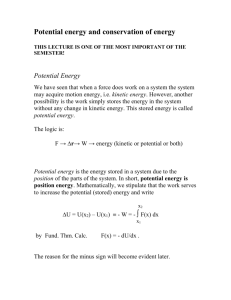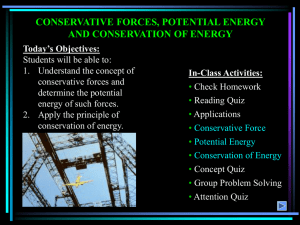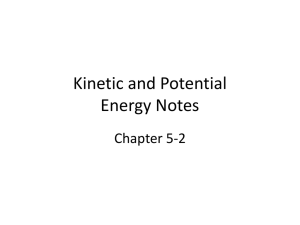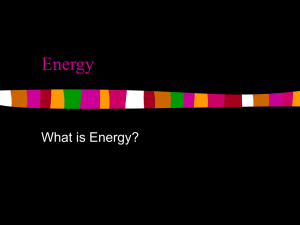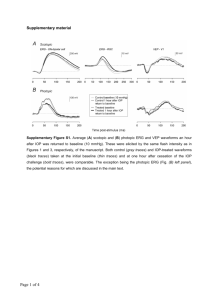gravitational potential energy - Course ON-LINE
advertisement
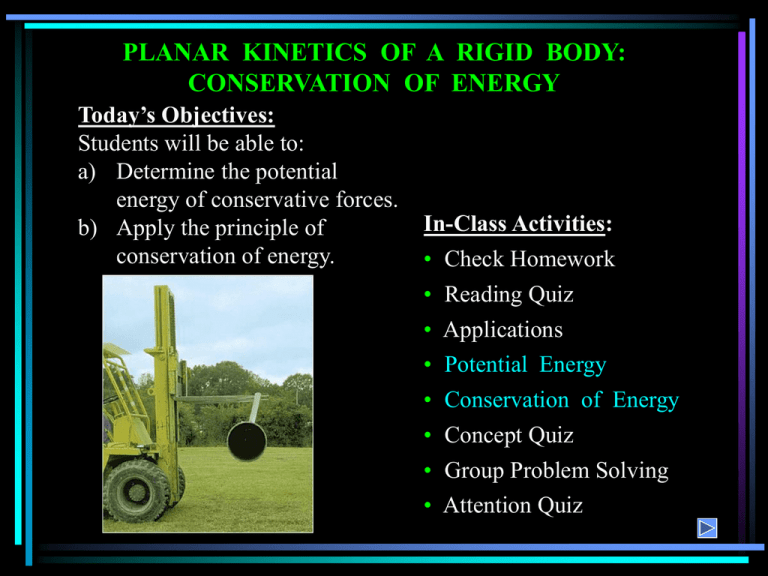
PLANAR KINETICS OF A RIGID BODY:
CONSERVATION OF ENERGY
Today’s Objectives:
Students will be able to:
a) Determine the potential
energy of conservative forces.
b) Apply the principle of
conservation of energy.
In-Class Activities:
• Check Homework
• Reading Quiz
• Applications
• Potential Energy
• Conservation of Energy
• Concept Quiz
• Group Problem Solving
• Attention Quiz
READING QUIZ
1. Elastic potential energy is defined as ___________.
A) + (1/2) k (s)2
B) - (1/2) k (s)2
C) + (1/2) k (v)2
D) None of the above
2. The kinetic energy of a rigid body consists of the
kinetic energy due to ___________.
A) translational motion and rotational motion
B) only rotational motion
C) only translational motion
D) the deformation of the body
APPLICATIONS
The torsion springs located at the top
of the garage door wind up as the door
is lowered.
When the door is raised, the potential
energy stored in the spring is
transferred into the gravitational
potential energy of the door’s weight,
thereby making it easy to open.
Are parameters such as the torsional
spring stiffness and initial rotation
angle of the spring important when
you install a new door?
APPLICATIONS (continued)
Two torsional springs are used to assist in
opening and closing the hood of the truck.
Assuming the springs are uncoiled when
the hood is opened, can we determine the
stiffness of each spring so that the hood
can easily be lifted, i.e., practically no
external force applied to it, when a person
is opening it?
Are the gravitational potential energy of the hood and the
torsional spring stiffness related to each other? If so, how?
CONSERVATION OF ENERGY
(Section 18.5)
The conservation of energy theorem is a “simpler” energy
method (recall that the principle of work and energy is also an
energy method) for solving problems.
Once again, the problem parameter of distance is a key indicator
for when conservation of energy is a good method to solve a
problem.
If it is appropriate for the problem, conservation of energy is
easier to use than the principle of work and energy.
This is because the calculation of the work of a conservative
force is simpler. But, what makes a force conservative?
CONSERVATIVE FORCES
A force F is conservative if the work done by the force is
independent of the path.
In this case, the work depends only on the initial and final
positions of the object with the path between the positions of
no consequence.
Typical conservative forces encountered in dynamics are
gravitational forces (i.e., weight) and elastic forces (i.e.,
springs).
What is a common force that is not conservative?
CONSERVATION OF ENERGY
When a rigid body is acted upon by a system of conservative
forces, the work done by these forces is conserved. Thus, the sum
of kinetic energy and potential energy remains constant.
This principle is called conservation of energy and is expressed as:
T1 + V1 = T2 + V2 = Constant
In other words, as a rigid body moves from one position to another
when acted upon by only conservative forces, kinetic energy is
converted to potential energy and vice versa.
GRAVITATIONAL POTENTIAL ENERGY
The gravitational potential energy of an object is a function
of the height of the body’s center of gravity above or below
a datum.
The gravitational potential
energy of a body is found
by the equation
Vg = W yG
Gravitational potential energy is positive when yG is positive,
since the weight has the ability to do positive work (why is it
positive?) when the body is moved back to the datum.
ELASTIC POTENTIAL ENERGY
Spring forces are also conservative forces.
The potential energy of
a spring force (F = ks)
is found by the equation
Ve = ½ k s2
Notice that the elastic potential energy is always positive.
PROCEDURE FOR ANALYSIS
Problems involving velocity, displacement and conservative force
systems can be solved using the conservation of energy equation.
• Potential energy: Draw two diagrams: one with the body
located at its initial position and one at the final position.
Compute the potential energy at each position using
V = Vg + Ve, where Vg= W yG and Ve = 1/2 k s2.
• Kinetic energy: Compute the kinetic energy of the rigid body at
each location. Kinetic energy has two components: translational
kinetic energy, 1/2m(vG)2, and rotational kinetic energy,1/2
IG2.
• Apply the conservation of energy equation.
EXAMPLE I
Given:The rod AB has a mass of
10 kg. Piston B is
attached to a spring of
constant k = 800 N/m.
The spring is un-stretched
when θ = 0°. Neglect the
mass of the pistons.
Find: The angular velocity of rod AB at θ = 0° if the rod is
released from rest when θ = 30°.
Plan: Use the energy conservation equation since all forces are
conservative and distance is a parameter (represented
here by θ). The potential energy and kinetic energy of
the rod at states 1 and 2 will have to be determined.
EXAMPLE I (continued)
Solution:
Initial Position
Final Position
Potential Energy:
Let’s put the datum in line with the rod when θ = 0°.
Then, the gravitational potential energy and the elastic potential
energy will be zero at position 2. V2 = 0
Gravitational potential energy at 1: - (10)( 9.81) ½ (0.4 sin 30°)
Elastic potential energy at 1: ½ (800) (0.4 sin 30°)2
So V1 = - 9.81 + 16.0 = 6.19 Nm
EXAMPLE I (continued)
Initial Position
Final Position
Kinetic Energy:
The rod is released from rest from position 1.
Therefore, T1 = 0.
At position 2, the angular velocity is 2 and the velocity at the
center of mass is vG2 .
Therefore, T2 = ½ (10)(vG2)2 + ½ (1/12)(10)(0.42)(2)2
EXAMPLE I (continued)
At position 2, point A is the instantaneous
center of rotation.
Hence, vG2 = rG/IC = 0.2 2 . Then,
T2 = 0.2 22 + 0.067 22 = 0.267 22
Now apply the conservation of energy equation and solve for
the unknown angular velocity, 2.
T1 + V1 = T2 + V2
0 + 6.19 = 0.26722 + 0 2 = 4.82 rad/s
EXAMPLE II
Given: The 30 kg rod is released
from rest when θ = 0.
The spring is unstretched
when θ = 0.
Find: The angular velocity of
the rod when θ = 30.
Plan:
Since distance is a parameter and all forces doing work are
conservative, use conservation of energy. Determine the
potential energy and kinetic energy of the system at both
positions and apply the conservation of energy equation.
EXAMPLE II (continued)
Solution:
Potential Energy:
Let’s put the datum in line with the
rod when θ = 0°.
Then, the gravitational potential
energy when θ = 30 is
Vg2 = -30 (9.81) (½ 1.5 sin 30°) = -110.4 Nm
Datum
The elastic potential energy at θ = 0 is zero since the spring is
un-stretched. The un-stretched length of the spring is 0.5 m.
The elastic potential energy at θ = 30 is
Ve2 = ½ 80 (√0.52+(1.5 sin 30°) 2 – 0.5)2 = 6.444 Nm
EXAMPLE II (continued)
Kinetic Energy:
The rod is released from rest at θ = 0°, so
vG1 = 0 and 1 = 0. Thus, the kinetic
energy at position 1 is T1 = 0.
At θ = 30°, the angular velocity is 2 and
the velocity at the center of mass is vG2 .
T2 = ½ m (vG2)2 + ½ IG (2)2
= ½ (30) (vG2)2 + ½ {(1/12) 30 (1.5)2} (2)2
Since vG2 = (0.75 2),
T2 = ½(30) (0.75 2)2 + ½{(1/12)30(1.5)2} (2) 2
T2 = 11.25 (2)2
Datum
EXAMPLE II
(continued)
Now all terms in the conservation of energy equation have been
formulated. Writing the general equation and then substituting
into it yields:
T1 + V1 = T2 + V2
0 + 0 = 11.25 (2)2 + (-110.4 + 6.444)
Solving , 2 = 3.04 rad/s
UNDERSTANDING QUIZ
1. At the instant shown, the spring is
undeformed. Determine the change in
potential energy if the 20 kg disk
(kG = 0.5 m) rolls 2 revolutions
without slipping.
3 m/s
datum
A) ½(200)(1.2)2 + (20)9.81(1.2 sin 30°)
B) - ½(200) (1.2)2 - (20)9.81(1.2 sin 30°)
C) ½(200)(1.2)2 - (20)9.81(1.2 sin 30°)
D) ½(200)(1.2)2
2. Determine the kinetic energy of the disk at this instant.
A) (½)(20)(3)2
B) ½(20)(0.52)(10)2
C) Answer A + Answer B
D) None of the above
GROUP PROBLEM SOLVING
Given: The 30 kg pendulum has its
mass center at G and a
radius of gyration about
point G of kG=0.3 m.
It is released from rest
when θ = 0. The spring is
unstretched when θ = 0.
Find: The angular velocity of the pendulum when θ = 90.
Plan: Conservative forces and distance (θ) leads to the use of
conservation of energy. First, determine the potential
energy and kinetic energy for both positions. Then
apply the conservation of energy equation.
GROUP PROBLEM SOLVING (continued)
Solution:
Potential Energy:
Let’s put the datum when θ = 0.
There the gravitational potential
energy is zero and the elastic
potential energy will be zero. So,
Vg1 = Ve1 = 0
Note that the unstretched length of
the spring is 0.15 m.
Gravitational potential energy at θ = 90:
Vg2 = - 30 (9.81) (0.35) = -103.0 Nm
Elastic potential energy at θ = 90 is :
Ve2 = ½ 300 (√ 0.62 + 0.452 – 0.15)2 = 54.0 Nm
GROUP PROBLEM SOLVING (continued)
Kinetic Energy:
When θ = 0°, the pendulum is
released from rest.
Thus, T1 = 0.
When θ = 90°, the pendulum has a
rotational motion about point O.
T2 = ½ IO (2)2
where IO = IG + m (dOG)2 = (30) 0.32 + 30 (0.35)2 = 6.375 kgm2
T2 = ½ 6.375 (2)2
GROUP PROBLEM SOLVING (continued)
Now, substitute into the
conservation of energy
equation.
T1 + V1 = T2 + V2
0 + 0 = = ½ 6.375 (2)2 + (-103 + 54.0)
Solving for yields
= 3.92 rad/s.
ATTENTION QUIZ
1. Blocks A and B are released from rest and the
disk turns 2 revolutions. The V2 of the system
1m
includes a term for ______________.
datum
A) only the 40 kg block
B) only the 80 kg block
40 kg
C) the disk and both blocks
80 kg
D) only the two blocks
2. A slender bar is released from rest while in the horizontal
position. The kinetic energy (T2) of the bar when it has
m
rotated through 90° is?
•
A) ½ m (vG2)2
B) ½ IG (2)2
L
C) ½ k (s1)2 - W (L/2)
D) ½ m (vG2)2 + ½ IG (2)2
